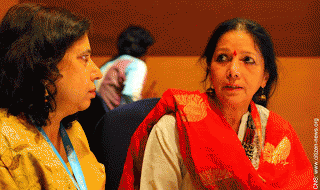Shobha Shukla, CNS (Citizen News Service)

Shobha Shukla, CNS (L), Dr Chitra Chandrashekar (R)
(Image by CNS (Citizen News Service)) Details DMCA
(CNS): So said award-winning Dr Chitra Chandrashekar, Director of Dr Iravatham's Clinical Laboratory, Hyderabad. I met her in Mumbai during NAPCON 2016 and was struck by her modesty and her passion for working in the field of TB. Chitra spoke with CNS (Citizen News Service) about her study titled
'Host susceptibility to Mycobacteria and Transmission dynamics', related to the transmission dynamics of TB, which won her the prestigious Professor OA Sarma Oration Award at NAPCON 2016.
Here is what Dr Chitra Chandrashekar shared:
"It is important to know why TB transmission continues unabated in high burden countries like India, despite there being tools to control it. My study investigated TB transmission dynamics and associated risk factors in the micro environment of urban slums, which are the hot spots of TB transmission. This first of its kind pilot study done in Hyderabad was conducted over a period of 3 years (2008-2011) and covered a population of 60,000 in 800 households. It took another 5 years to collate the data."
Mapping TB hot spots:
"We took the houses' addresses of patients coming for treatment from this particular slum from the DOTS centre TB registry of the area. But when we went there we could not locate a single house, due to the very random distribution of houses, even though all addresses were correct. We returned disappointed, but more determined than before. With the help of the local postman, we were finally able to record the coordinates of each individual house and map the entire area. These updated addresses were entered in the TB registry. We could now identify household contacts, the source of contact, those affected in the neighbourhood of each contact, the minimal time duration by which the next contact was infected. All this information based on 10 years data was collated and put in graphical representation in a 3 dimensional map form. This type of mapping when displayed in the DOTS centre, enabled one to know where the next source of infection would be located for anyone coming from that area."
"By making use of the latest GPS technology and with help from our network of postal department, we can generate these simple maps in DOTS centres to identify sources of infection and thus take effective preventive measures for TB control."
Risk factors
(Note: You can view every article as one long page if you sign up as an Advocate Member, or higher).





